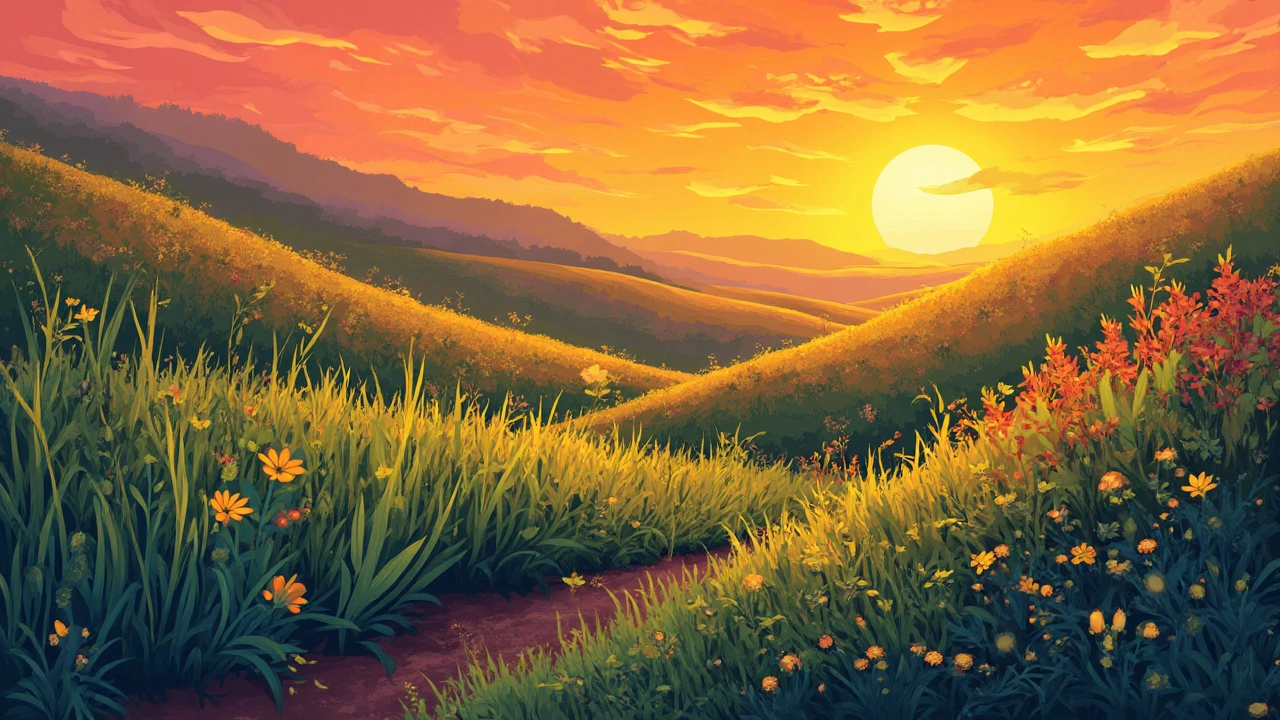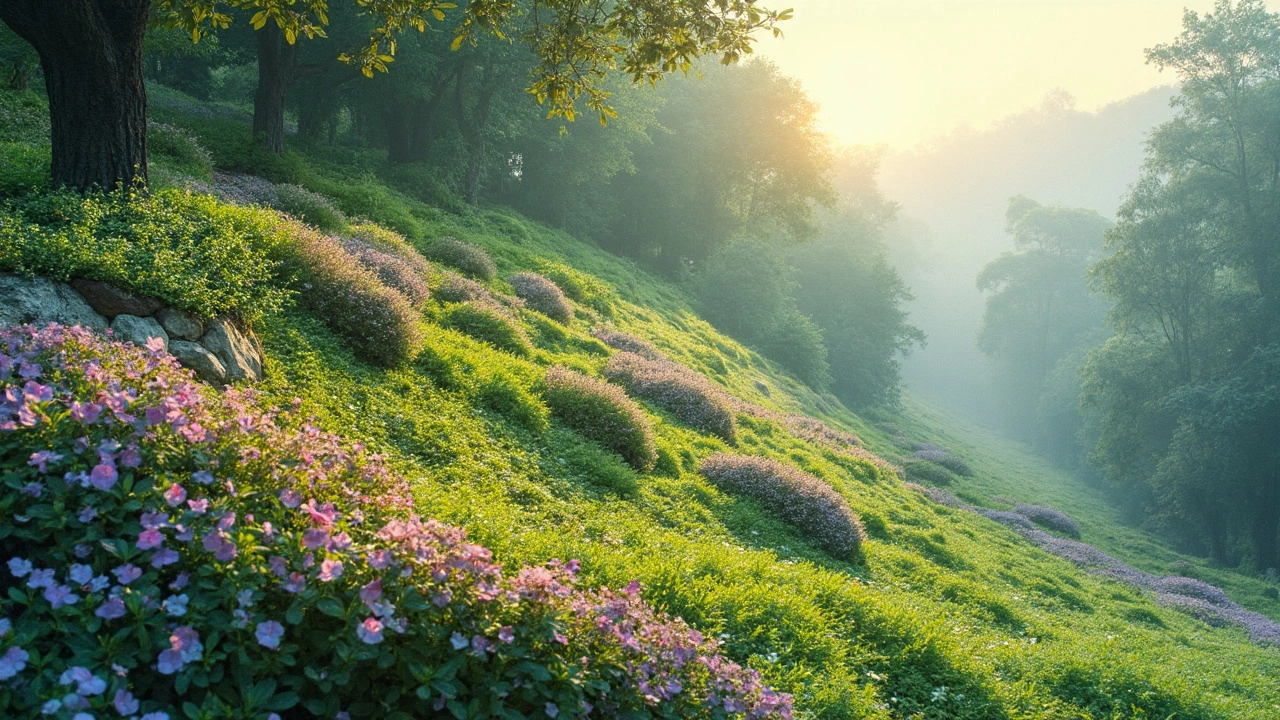Got a hillside garden that's more slip-n-slide than serene oasis? You're not alone, and here's the deal—hillside erosion can be a real headache. Left unchecked, it can wash away soil, harm plant life, and make your outdoor spots look, well, a bit sad. But before you throw your hands up in defeat, here’s something cool: using the right ground cover can stop erosion in its tracks!
Let's break this down. Some plants aren't just pretty—they're tough as nails and perfect for anchoring your soil. Think of them as nature's own way of keeping hillsides in check. We're talking about fast-spreaders like creeping juniper or clover, which not only look great but also do a fab job of holding the earth together. The trick is picking the right one for your specific spot.
Choosing the right ground cover doesn't just keep dirt in place; it ups your garden's style game, too. Whether you're planting natives for lower maintenance or hooking up with some showy, lush picks, there's a fantastic range out there. But, quick tip—it's not just about planting any old plant. You gotta think ahead, consider your local climate, the amount of sun your hillside gets, and so on.
- Understanding Hillside Erosion
- Top Ground Covers for Hillsides
- Benefits of Proper Plant Choices
- Planting Techniques
- Maintenance and Upkeep
Understanding Hillside Erosion
Alright, let's unpack why hillside erosion is such a big deal. When it rains, water naturally flows downhill, which can pick up soil along the way if there's nothing around to hold it back. Over time, those trickles turn into rut-fests, gouging out bits of your hillside garden. If not controlled, this erosion can lead to larger problems like landslides or damage to nearby structures.
Most of the time, hillside erosion gets its foot in the door because of barren soil and poor plant coverage. Without dense plant roots to hold the soil together, it’s like a free-for-all for rainwater. Addressing this starts with picking the right plants, but it's also about understanding what's at play.
Factors like soil type and slope steepness matter. Sandy soils, for instance, have larger pores, letting water move quickly and increase erosion risks. On the other end, clay soils hold water and can become unstable when saturated. Plus, the angle of your slope plays into the equation—steeper slopes face more erosion due to faster water runoff.
A bit of interesting data for you: a study on soil loss found that grassy covers can reduce erosion by up to 90%. That's huge! So, picking the right ground cover does more than just pretty up the place—it saves your soil.
All this said, some areas need more than just plants. Effective erosion control might involve a mix of strategies like terracing or installing geotextiles, especially if you're dealing with a high-risk slope. It's about layering your defenses; plants are a key layer, but sometimes they need backup.
Keep these basics in mind as we dive deeper into which ground cover plants could turn your prone-to-erosion hill into a solid, blooming beauty.
Top Ground Covers for Hillsides
Choosing the right ground cover for your hill can change the whole vibe of your garden—plus, it’s crucial for keeping that pesky erosion at bay. Let’s chat about some top choices that are not just foot-friendly but also workhorses in preventing soil from sliding off your slopes.
First up, we've got the creeping juniper. This one's your go-to if you're in the market for something that spreads like wildfire—think green carpet vibes with less hassle. It’s low-maintenance and can handle a variety of soil conditions. Hardy and evergreen, creeping juniper is perfect if you want year-round greenery.
Next, check out clover. It’s not just for lucky charms; it’s like a multitasker for sloped gardens. Clover fixes nitrogen, improving soil fertility, and it’s a champ at crowding out weeds, which means less work for you.
Now, if you like your hillside bursting with color, ice plant might be your pick. This beauty brings vibrant pink blossoms and its succulent leaves hold water, making it ideal for dryer climates. Plus, it forms a dense mat that keeps the ground tucked in tight.
For those who want a mix of height and ground coverage, the stalwart periwinkle is an all-rounder. This plant sports lovely purple flowers and thrives in shaded or partially sunny areas. It’s particularly good if you're dealing with a range of sunlight conditions on your slope.
If you’re willing to put a little more effort in and maybe get your hands a bit dirty, try Bergenia. This one's a bit of a triple threat—big leaves, pretty flowers, and fiery red foliage come fall. What’s not to love?
- Fast-spreaders: Creeping juniper, clover
- Colorful additions: Ice plant, periwinkle
- Unique picks: Bergenia
Remember, while the right plant can work wonders, how you plant them is just as key. Space them well so they’ve got room to grow without taking over entirely. Want more variety? Pick a combo of these plants for a hillside that’s not only held firm but looks like a million bucks!

Benefits of Proper Plant Choices
Picking the right ground cover for your hillside isn't just about keeping things in place; it's like giving your garden a superpower. The right plants can work wonders, turning a problematic slope into the pride of your backyard.
First off, some ground covers are naturals at soil conservation. Creeping juniper, for instance, with its spreading, root-hugging nature, really digs in, keeping everything stable. Same with clover—its dense growth prevents soil from washing away.
These plant choices aren’t just about function. They bring an aesthetic boost, too. Imagine replacing bare patches with lush greenery that invites butterflies and bees. Wildlife loves a well-planted slope.
And here's a bonus: by thoughtfully selecting plants adapted to your region and conditions, you cut down on maintenance. Native plants especially are a win—they need less water and are usually more resilient to pests, saving you time and energy. Less mowing and watering? Yes, please!
If you want numbers, think about this: planting native species can reduce landscaping costs by up to 50% compared to non-native species. That's more money in your pocket, along with a thriving garden.
So, don’t just go with any plant. Take the time to choose and see your hillside transformed into a feature that works hard for you, not against.
Planting Techniques
So you’ve picked out the best ground cover for your hillside. Awesome! But planting these green champs is a bit different when you’re working on a gradient. Let’s chat about the best ways to make sure your plants settle in nicely and actually control that erosion like pros.
First up, timing. While you can plant most ground covers any time of the year, early spring or during fall are often the sweet spots to let roots establish before summer’s heat kicks in or winter's chill settles. Next, you’ll want to prep the soil. Loose soil encourages roots to dig in deep, so grab a spade and loosen it up a bit before you start.
Plant spacing counts big time too. Aim for a bit of space between your plants — let's say about 12 to 18 inches — giving them room to spread without feeling squashed. If you’re wondering how deep to plant, the golden rule is always to go no deeper than the existing root ball of your plant. This keeps them from suffocating.
Setting up rows is a neat trick for planting on a slope. Working your way downhill in horizontal rows is easier and helps with even spacing. You can use a natural line like a stick or a rope to get those rows nice and straight if that’s your thing. And remember, mulch is your buddy here! Tossing a light layer of mulch around your plants controls weeds and keeps moisture locked in.
Once planted, don’t just forget about them! Water them gently at first, and keep an eye out for any plants that look like they’re not happy. If it rains like crazy or you have a major drought, you may need to adjust your watering schedule. Happy, healthy plants mean stable, pretty hillsides.

Maintenance and Upkeep
Got your ground cover in place? Awesome, but the job’s just beginning. Keeping those plants healthy and effective at controlling erosion means rolling up your sleeves now and then.
First off, let's talk watering. Ground covers don't need a daily soaking, but they're not set-it-and-forget-it either. Depending on your local climate and the variety you’ve planted, a deep soak once a week might be just the ticket. Check the soil moisture with a finger test—if it feels dry an inch under, it’s time for a drink.
Next up, weeding—yup, those pesky plants can crowd out your garden beauties. Routine checks and quick removal of any unwanted guests keep your hillside looking lush and healthy. Remember, healthy competition is what you want here!
- Fertilizing: Give your ground cover a boost with a slow-release, balanced fertilizer once a year, preferably in spring. It’s like giving your plants breakfast before a long day of work.
- Pruning: Some ground covers, like ivy, can get a bit too enthusiastic. Trim them back to prevent them from taking over everything in sight.
- Pest Control: Keep an eye out for unwelcome visitors like aphids or grubs. Natural predators like ladybugs can be a gardener’s best buddy, reducing the need for chemicals.
Finally, check for any signs of erosion after heavy rainfall. Loose soil, exposed roots, or increased water run-off are red flags. If you spot issues, adding mulch or more plants might be necessary to beef up your line of defense.
With the right care, your hillside won’t just fend off erosion—it’ll thrive. And really, who doesn’t want a garden that’s as stunning as it is sturdy?

